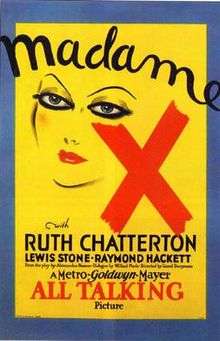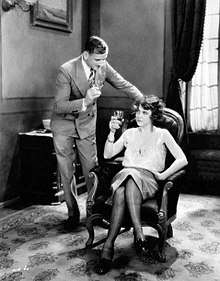Madame X (1929 film)
Madame X is a 1929 American Pre-Code drama film directed by Lionel Barrymore, and starring Ruth Chatterton as a fallen woman who longs to be reunited with her son. The film is based on the 1908 play Madame X by French playwright Alexandre Bisson (1848-1912).
| Madame X | |
|---|---|
 Film poster | |
| Directed by | Lionel Barrymore |
| Written by | Alexandre Bisson (play) Willard Mack |
| Starring | Ruth Chatterton Lewis Stone |
| Music by | William Axt |
| Cinematography | Arthur Reed |
| Edited by | William S. Gray |
| Distributed by | Metro-Goldwyn-Mayer |
Release date |
|
Running time | 95 minutes |
| Country | United States |
| Language | English |
Plot

Jacqueline Floriot (Chatterton) is thrown out into the street without any money by her jealous husband Louis (Lewis Stone) when he discovers she had been carrying on an affair. She is not even allowed to see their four-year-old son, and sinks into depravity. Twenty years later, she has become the mistress of Laroque (Ullrich Haupt), a cardsharp. When he finds out that her husband is now the attorney general, Laroque decides to blackmail him. Desperate to shield her son from her disgrace, she shoots and kills her lover.
By chance, the lawyer assigned to her turns out to be her own son, on his first case. He is puzzled and frustrated when she refuses to defend herself in court. During the trial, her husband shows up in support of his son. When she sees that he recognizes her and is about to speak out, she makes an impassioned plea, not for mercy, but for understanding of what drove her to murder. As she had intended, the hidden message silences Louis. When Jacqueline faints from the strain, she is carried into a private chamber. There, she kisses her still-unaware son and dies.
Cast
|
|
Notes
The story had been filmed before by Goldwyn Pictures in 1920 with Pauline Frederick. This was four years before the merger of Goldwyn with two other film studios that led to MGM. MGM inherited the screen rights to the story following the 1924 merger.
No music is heard under the opening or closing credits of Madame X, which was the result of a short-lived practice in which studios expected the local theater musicians to provide live accompaniment to the opening credits of sound films. Because keyboardists and orchestras were still working in the theaters in the late 1920s providing music for silent films still in distribution, live music was a way to make the screening more of a special event and not a purely "canned" presentation.[1]
Barrymore consciously avoided the song-and-dance formula that dominated early sound pictures, treating Madame X as a dramatic play. To emphasize the film's credentials as a serious drama and avoid any music hall associations, MGM premiered the film in New York City's Sam H. Harris Theater, a legitimate stage venue that was rented for the occasion.[1]
Considered for Academy Award nomination
- Considerations[2]
- Best Directing: Lionel Barrymore
- Best Actress: Ruth Chatterton
However, these were not official "nominations." According to AMPAS, "there were no announcements of nominations, no certificates of nomination or honorable mention, and only the winners (*) were revealed during the awards banquet on April 3, 1930. Though not official nominations, the additional names in each category, according to in-house records, were under consideration by the various boards of judges."
See also
- Madame X disambiguation page
References
- "Madame X". Turner Classic Movies. Retrieved February 25, 2014.
- "The 2nd Academy Awards (1929/30) Nominees and Winners". Academy of Motion Picture Arts and Sciences. Retrieved February 25, 2014.